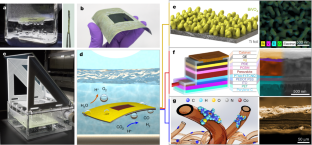海塩を吸湿剤として使用し、従来の単三電池より高い電気出力を実現した充電式布製電池。 Using sea salt as an eco-friendly moisture absorbent, this rechargeable fabric-like ‘battery’ provides higher electrical output than a conventional AA battery – potentially powering everyday electronics
2022-08-17 シンガポール国立大学(NUS)
 The new moisture-driven electricity generation device invented by NUS researchers capitalises on the difference in moisture content of the wet and dry regions of the carbon-coated fabric to create an electric current. Sea salt is used as a moisture absorbent for the wet region.
The new moisture-driven electricity generation device invented by NUS researchers capitalises on the difference in moisture content of the wet and dry regions of the carbon-coated fabric to create an electric current. Sea salt is used as a moisture absorbent for the wet region.
布の一部分は吸湿性のあるイオン性ハイドロゲルでコーティングされており、この部分はウェット領域と呼ばれている。海塩を使って作られたこの特殊な吸水ゲルは、元の重量の6倍以上の水分を吸収することができ、空気中の水分を採取するために使用される。
もう一方の生地は、吸湿性のあるイオンハイドロゲル層を含まない乾燥領域です。これは、この部分を確実に乾燥させ、水は湿潤領域に閉じ込めるためです。
湿潤領域と乾燥領域を独自に設計することで、湿潤領域では高い含水率を、乾燥領域では低い含水率を維持することに成功した。これにより、湿潤領域が水で飽和した場合でも、電気出力を維持することができる。湿度の高い屋外環境に30日間放置した後も、湿潤領域では水分が維持されており、このデバイスが電気出力を維持するのに有効であることが示された。
また、開発したMEGデバイスは高い柔軟性を示し、ねじれや転がり、曲げなどのストレスに耐えることができた。
吸水後、1.5×2センチメートルの大きさの発電布1枚で、一定の環境下で150時間以上、最大0.7ボルト(V)の電力を供給できる。
<関連情報>
- https://news.nus.edu.sg/self-charging-ultra-thin-device-that-generates-electricity-from-air-moisture/
- https://onlinelibrary.wiley.com/doi/abs/10.1002/adma.202201228
水分駆動型ハイグロイオニック発電・貯蔵のための非対称吸湿構造体 An Asymmetric Hygroscopic Structure for Moisture-Driven Hygro-Ionic Electricity Generation and Storage
Yaoxin Zhang,Shuai Guo,Zhi Gen Yu,Hao Qu,Wanxin Sun,Jiachen Yang,Lakshmi Suresh,Xueping Zhang,J. Justin Koh,Swee Ching Tan
Advanced Materials Published: 25 March 2022
DOI:https://doi.org/10.1002/adma.202201228
Abstract
The interactions between moisture and materials give rise to the possibility of moisture-driven energy generation (MEG). Current MEG materials and devices only establish this interaction during water sorption in specific configurations, and conversion is eventually ceased by saturated water uptake. This paper reports an asymmetric hygroscopic structure (AHS) that simultaneously achieves energy harvesting and storage from moisture absorption. The AHS is constructed by the asymmetric deposition of a hygroscopic ionic hydrogel over a layer of functionalized carbon. Water absorbed from the air creates wet-dry asymmetry across the AHS and hence an in-plane electric field. The asymmetry can be perpetually maintained even after saturated water absorption. The absorbed water triggers the spontaneous development of an electrical double layer (EDL) over the carbon surface, which is termed a hygro-ionic process, accounting for the capacitive properties of the AHS. A peak power density of 70 µW cm-3 was realized after geometry optimization. The AHS shows the ability to be recharged either by itself owing to a self-regeneration effect or via external electrical means, which allows it to serve as an energy storage device. In addition to insights into moisture-material interaction, AHSs further shows potential for electronics powering in assembled devices.



